Repetition Tempo for Muscular Hypertrophy
Written by: Andrew D. Katson
Introduction
Hypertrophy-focused resistance training, whether it be with body weight, bands, or barbells, is an effective way to improve bone health, mobility, and muscular strength and size. This form of exercise has both aesthetic and practical uses in day-to-day life. When training for muscular hypertrophy (increased muscle size), lifting technique plays an important role in determining the safety and effectiveness of an exercise. To that end, this article will discuss the theoretical and practical implications of various scientific research from a biomechanical and mechanistic perspective to maximize the effect of hypertrophy training.
Definitions
Before delving into the research, we need to define a few terms. Every movement consists of three phases: eccentric, isometric, and concentric. The eccentric phase is the part of the motion in which the muscle is lengthened under load, like the lowering phase of a squat. Isometrics consist of movements in which the muscle holds one length, such as the quadriceps in a wall sit or the rectus abdominis in the plank or push-up. Lastly, the concentric phase consists of a shortening of the muscle under load, like the “pushing away” part of a pushup or the lowering phase of a deadlift. Collectively, these three movements form the range of motion (ROM) of any movement, measured by the angle through which the joint moves (Cannon, 2020). Figures 1 and 2 illustrate these concepts.
Figure 1

The eccentric, isometric, and concentric demonstrated using a bicep curl.
Source: Fitbliss Fitness
Figure 2
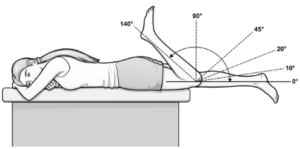
The range of motion on a hamstring curl. In this diagram, the ROM varies from full extension to 145 degrees of knee flexion.
Source: OSMS
Biomechanics can also be approached from a physics aspect. In physics, torque is defined as a measure of the ability of a force to produce angular acceleration, causing an object to rotate. Muscular torque works the same way: your muscles contract to produce a torque, “turning” the load in a circular manner, with the axis of rotation as your joint. For example, in performing a bicep curl in Figure 1, the force of gravity produces a clockwise torque toward the ground, thereby “uncurling” your arm and extending your joint. To counteract the torque toward the ground, the tension in the muscle generates a counterclockwise torque (see Figure 3) about the elbow.
Figure 3
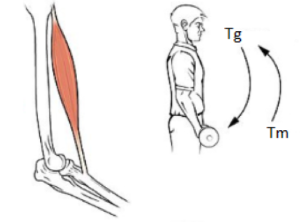
A diagram of the clockwise torque produced by gravity and the counterclockwise torque produced by the bicep. If the resistance remains at a constant speed, like in an isometric hold, these torques cancel out and produce zero net torque and thus zero net rotation.
Source: Adapted from Fitbliss Fitness
The torque depends on the moment arm and the force applied, where the moment arm is the perpendicular distance from the axis of rotation to the force applied (Hik and Ackland, 2019). In Figure 4, we can see that the shorter the moment arm, shown in green, the less torque and tension the muscle needs to generate. To increase the tension on the muscle, we need to increase the moment arm (Rogers, 2023). This can be done by changing the positioning of the elbow or by changing the position of the force applied.
Figure 4

The moment arms, shown in green, are the perpendicular distance from the joint to the green line of force. Note that the longer the moment arm, the greater the torque. For the cable, the moment arm and torque is greatest when the forearm is in the direction of the moment arm.
Source: National Library of Medicine
Mechanisms
By understanding the hypertrophy mechanisms and sensors of the body, one can apply the proper stimulus to maximize the hypertrophic response. While how resistance training stimulates skeletal muscle hypertrophy remains unknown, there are some plausible candidates. The hypothesized “hypertrophy stimuli” are mechanical stress, metabolic stress, and muscle damage. Mechanical stress, also known as mechanical tension, is the application of force or tension to the muscle cells. Metabolic stress is the build-up of metabolites, the chemical byproducts of muscle contraction, in the surrounding environment. Several chemical changes characterize metabolic stress, including low phosphocreatine concentrations, high lactate concentrations, and low pH, often affecting the body’s energy systems. Lastly, muscle damage is the physical microtearing of muscle, often due to engaging in novel forms of exercise (Wackerhage et al., 2019).
In order to determine how each stimulus promotes the varying hypertrophic responses, one needs to identify and explain the sensors for each of these hypertrophy stimuli as well as the signaling cascades that follow. Out of the three hypothesized stimuli, mechanical stress seems to be the most likely explanation because of the many promising mechanosensors identified, including those related to nuclear deformation and costameres, shown in figure 5. The use of blood-flow restriction training, in which bands are tied around the muscle to increase metabolite build up, demonstrates that low-load high-metabolite conditions also stimulate hypertrophy, but the exact entire mechanism remains unknown. Thus, metabolite stress likely contributes to the hypertrophy stimulus, but not in the same manner. Lastly, muscle damage does not seem necessary for a hypertrophic stimulus, and the degree to which muscle damage contributes to hypertrophy remains unclear. Furthermore, muscle damage can result directly from mechanical stress, so it is difficult to determine whether it alone can cause muscle growth. For example, muscle damage occurs in endurance sports and severe injuries, where hypertrophy may not occur (Wackerhage et al., 2019).
Figure 5
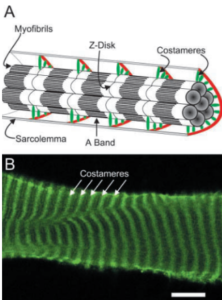
The anatomy of a muscle cell, with costameres labeled. Costameres are parts of the muscle cell which laterally transmit force from the sarcomeres (contractile units inside the muscle cell) to the sarcolemma and neighboring muscle cells .
Source: The Journal of Biological Chemistry
Biomechanics
Recent studies have shown that longer muscle lengths are superior for isometric strength (force production) in most ranges of motion. A similar result was shown for hypertrophy, as longer muscle lengths generally produce higher mechanical tension because the moment arm is longer as shown in Figures 4 and 6. Increased mechanical tension and higher torques would prompt the growth of sarcomeres, inducing greater hypertrophy. It should be noted that if torques are equated, the length of the muscle does not seem to have a significant effect on hypertrophy, but, practically, the highest torque occurs at longer muscle lengths (Nunes et al., 2020). Longer muscle lengths also cause greater muscle damage, which may induce greater hypertrophy. The titin protein of the muscle also generates more force at longer muscle lengths, possibly signaling a hypertrophic response. Overall, the literature seems to suggest that longer muscle lengths may cause greater hypertrophy than shorter ones (Wackerhage et al., 2019).
Figure 6
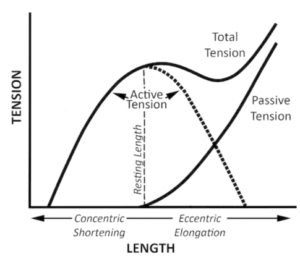
The relationship between muscle length and tension. Passive tension results from the “spring” like nature of muscles, but still contributes to total mechanical tension. Note where mechanical stress tends to be highest.
Source: American Association of Anatomy
In regards to repetition tempo, the repetition speed does not seem to matter. In a meta-analysis by Schoenfeld et al., the study concluded that repetition tempos of 0.5 to 8 seconds per repetition produced similar muscular hypertrophy (Schoenfeld et al., 2015). This is likely because shorter repetition tempos are easier, allowing the trainee to complete more repetitions. Thus, repetition tempo is counteracted by repetition count, delivering the same net stimulus.
Eccentric, Isometric, or Concentric?
In regards to muscle damage, eccentric actions with a large range of motion have the most impact. The eccentric (lengthening) action of a movement is easier than the concentric, so the eccentric portion can also be loaded more heavily– hence the term “eccentric overload” (Wackerhage et al., 2019). The metabolic cost for eccentric actions is approximately four times less than the concentric action, requiring less oxygen and energy for each unit of muscle force. Hody et al., writes “the two main defining properties of eccentric contraction ‘highest forces and lower energy requirement’ makes this contraction regime a judicious alternative to conventional muscle training”, “ the systematic inclusion of eccentric-based protocols into training programs is recommended for most competitive sports” (2019). Thus, the eccentric action seems to offer unique advantages and should be emphasized during resistance training.
For isometric training, however, one must consider the length of the muscle at which the resistance is held. Isometric training at relatively long muscle lengths seems to increase strength and muscle size significantly more than shorter muscle lengths. It also seems that isometric training at longer muscle lengths transfers to other parts of the range of motion much better than isometric training at shorter muscle lengths (Oranchuk et al., 2018). Thus, the “pause” portion of most ROMs in hypertrophy training should be at the stretched muscle length, at which greater torques and higher tensions are achieved (see figure 7).
Figure 7
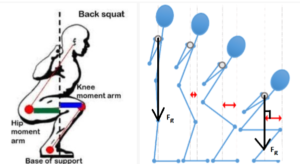
At the bottom of the squat, the glutes and quadriceps are at the longest muscle length. The stretched position also corresponds to longer moment arms, and therefore more torque and tension.
Source: National Federation of Professional Trainers, Fitness Pollenator
Implications
The current biomechanical and mechanistic scientific literature thus gives us important information about exercise selection. As a hypertrophy trainee, one should select exercises that place the most tension at the longest muscle length. This exercise should then be completed with a pause at the longest muscle length, a slow eccentric, and a fast but controlled concentric through a full range of motion. This technique would maximize signaling through mechanical tension, muscle damage, and metabolic stress, increasing effectiveness while decreasing risk of injury.
Example:
Suppose an individual was to apply this technique to a dumbbell chest fly. One would place themselves into position with dumbbells overhead, arms partially extended. Then the eccentric phase would begin and the dumbbells would be lowered slowly in a circular manner to the stretched position. At the bottom, with the dumbbells level with the pectoralis major (chest), the trainee would pause at the stretched position for one or several seconds. The focus here would be on pre-stretching the chest while driving maximal tension through it. Lastly, the repetition is completed with a controlled contraction, pushing the weights back together. Since the pectoralis is fully stretched when peak torque is applied (longest moment arm), its force curve is optimal for hypertrophy. The ideal form is detailed in Figure 8.
Figure 8
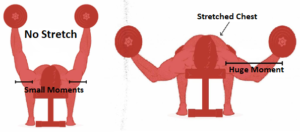
A diagram depicting the moment arms (thus the amount of force produced) and the degree of stretch in the chest. The chest fly is a strong choice for hypertrophy training, as it exposes the pectoralis to maximal resistance at a stretched position.
Source: Outlift
Conclusion
Hypertrophy training is important for everyone– it improves a wide variety of health markers, including metabolic health, cancer risk, all-cause mortality risk, mobility, and cognitive function (Adou Sawan et al.). By examining scientific literature to devise a general recommendation for hypertrophy training, both everyday gym-goers and those just starting their fitness journey can experience the benefits of resistance training to the fullest.
References and Sources
Abou Sawan, S., Nunes, E. A., & Lim, C. (2023, Winter). The health benefits of resistance exercise: Beyond… : Exercise, sport, and Movement. LWW. https://journals.lww.com/acsm-esm/fulltext/2023/01000/the_health_benefits_of_resistance_exercise__beyond.2.aspx)
Cannon, A. (2020, August 7). Concentric, eccentric, isometric, tempo… what does it all mean?. Fitblissfitness.com. https://fitblissfitness.com/2020/08/07/concentric-eccentric-isometric-tempo-what-does-it-all-mean/
Duquette, S., & Walker-Ng, M. (2020, September 22). The dumbbell fly versus the cable crossover. Outlift. https://outlift.com/dumbbell-vs-cable-fly/
Ervasti, J. M. (2003, January 29). Costameres: The achilles’ heel of Herculean muscle*. The Journal of Biological Chemistry . https://www.jbc.org/article/S0021-9258(19)64491-1/pdf
Hik, F., & Ackland, D. C. (2019, January). The moment arms of the muscles spanning the glenohumeral joint: A systematic review. Journal of anatomy. https://www.ncbi.nlm.nih.gov/pmc/articles/PMC6284439/
Hody, S., Croisier, J.-L., Bury, T., Rogister, B., & Leprince, P. (2019, April 15). Eccentric muscle contractions: Risks and benefits. Frontiers. https://www.frontiersin.org/articles/10.3389/fphys.2019.00536/full?fbclid=IwAR2bSWVfxDiYoBS3GYoNvHkIKlC7WcdvxvPjwurv9rKk_pXtOZ_rBSB7qnk
Nunes, J. P., Jacinto, J. L., & Ribeiro, A. S. (2020, August). Placing Greater Torque at Shorter or Longer Muscle Lengths? Effects of Cable vs. Barbell Preacher Curl Training on Muscular Strength and Hypertrophy in Young Adults. National Library of Medicine. https://www.ncbi.nlm.nih.gov/pmc/articles/PMC7460162/
Pollen, T. (2015, May 22). Brief lessons in biomechanics: Moment arms. Fitness Pollenator. http://www.fitnesspollenator.com/2015/05/brief-lessons-in-biomechanics-moment-arms.html
Rogers, M. (2023, November 25). Moment arms in exercise: A brief introduction to the physics of Movement. National Federation of Professional Trainers. https://www.nfpt.com/blog/moment-arms
Oranchuk, D. J., Storey , A. G., & Nelson, A. R. (2018, December 23). Isometric training and long‐term adaptations: Effects of muscle length, intensity, and intent: A systematic review. Wiley Online Library. https://onlinelibrary.wiley.com/doi/10.1111/sms.13375
Schoenfeld, B. J., Ogborn, D. I., & Krieger, J. W. (2015, January 20). Effect of repetition duration during resistance training on muscle hypertrophy: A systematic review and meta-analysis – sports medicine. SpringerLink. https://link.springer.com/article/10.1007/s40279-015-0304-0
Simpson, S. W., Latimer, B., & Lovejoy, C. O. (2008, February 8). Why do knuckle‐walking african apes knuckle‐walk? – Simpson … American Association for Anatomy. https://anatomypubs.onlinelibrary.wiley.com/doi/10.1002/ar.23743
Wackerhage, H., Schoenfeld , B., Lee Hamilton, D., & Jou, J. J. (2019, January 9). Stimuli and sensors that initiate skeletal muscle hypertrophy following resistance exercise. Journal of Applied Physiology. https://journals.physiology.org/doi/full/10.1152/japplpHysiol.00685.2018?rfr_dat=cr_pub++0pubmed&url_ver=Z39.88-2003&rfr_id=ori%3Arid%3Acrossref.org